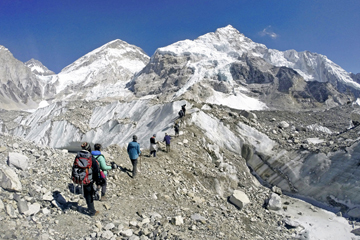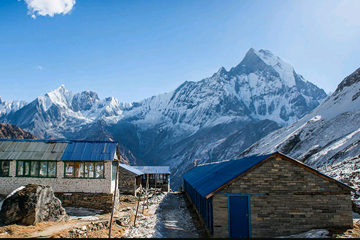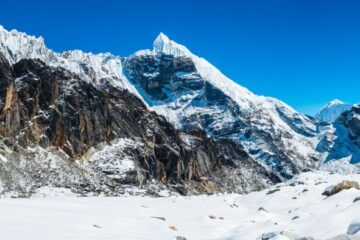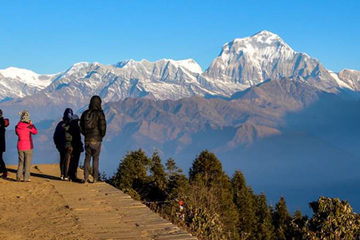Gokyo Lakes, Chola Pass and Everest Trek is an adventurous trek in the Khumbu region. Everest Base Camp and Gokyo valley are the destinations of this trek via technical Cho La Pass.
Gokyo Everest base camp is one of the prominent and testing trekking trails in the Everest area and one of Nepal’s generally extremely popular treks to the Khumbu Mountains and Sherpa nation.
Gokyo Chola Pass Trek consolidates lovely Gokyo Valley Trek, Gokyo Ri, EBC Chola Pass Gokyo Trek Trail.
Duration:
- The trek typically takes around 15 to 18 days, depending on the route taken and individual acclimatization needs.
Highlights Of Gokyo Lake Cho La Pass Everest Trek
Trekking to Gokyo Lakes and crossing Cho La Pass in the Everest region of Nepal is a remarkable adventure that offers stunning views of some of the world’s highest peaks, unique landscapes, and cultural experiences. Here are some trip highlights you might encounter:
- Gokyo Lakes: These are a series of six turquoise lakes in the Gokyo Valley, set against the backdrop of towering Himalayan peaks. The lakes are considered sacred by both Hindus and Buddhists and are a stunning sight for trekkers.
- Cho La Pass: Crossing Cho La Pass is one of the most challenging and exhilarating parts of the trek. At an altitude of 5,420 meters (17,782 feet), it offers breathtaking panoramic views of Everest, Lhotse, Nuptse, and other surrounding peaks. The pass can be snowy and icy, making it a thrilling and adventurous experience.
- Everest Base Camp: While the main destination of this trek isn’t Everest Base Camp itself, many trekkers choose to make a detour to the base camp either before or after crossing Cho La Pass. It’s an opportunity to get up close to the world’s highest peak and experience the iconic surroundings that have drawn adventurers for decades.
- Gokyo Ri: This is a popular viewpoint near Gokyo Lakes, offering stunning panoramic views of Everest, Lhotse, Makalu, and Cho Oyu, among other peaks. The sunrise and sunset views from Gokyo Ri are particularly spectacular and are not to be missed.
- Sherpa Culture: Throughout the trek, you’ll have the opportunity to immerse yourself in Sherpa culture. You’ll encounter traditional Sherpa villages, monasteries, and prayer flags along the way, providing insights into the rich cultural heritage of the region.
- Challenging Terrain: The trekking route to Gokyo Lakes and Cho La Pass involves a variety of terrain, including steep ascents, rocky paths, and potentially icy conditions at higher altitudes. It’s a physically demanding trek that requires a good level of fitness and acclimatization.
- Unique Flora and Fauna: Despite the harsh conditions, the Everest region is home to a surprising variety of flora and fauna, including rare species such as the snow leopard, Himalayan tahr, and musk deer. Keep an eye out for colorful rhododendron forests, juniper trees, and elusive wildlife along the trail.
- Fellow Trekkers: The Everest region attracts trekkers from all over the world, creating a vibrant and diverse trekking community on the trail. You’ll have the opportunity to meet fellow adventurers, share stories, and form lasting friendships as you journey through this spectacular landscape.
Overall, trekking to Gokyo Lakes and crossing Cho La Pass is a once-in-a-lifetime experience that combines breathtaking natural beauty, cultural immersion, and physical challenge, making it a highlight for many outdoor enthusiasts.
Difficulty:
- The Gokyo Chola Pass Everest trek is considered strenuous due to high altitudes, challenging terrain, and potentially harsh weather conditions. Proper acclimatization, physical fitness, and preparation are essential for a safe and enjoyable trek.
Permits:
- Trekkers are required to obtain permits, including the Sagarmatha National Park Entry Permit and the TIMS (Trekkers’ Information Management System) card, before embarking on the trek.
Guided vs. Independent Trekking:
- While it’s possible to trek independently, many trekkers opt for guided tours led by experienced local guides and Sherpas. Guided tours provide logistical support, safety guidance, and cultural insights, enhancing the overall trekking experience.
Overall, the Gokyo Chola Pass Everest trek is a bucket-list adventure that offers a perfect blend of natural beauty, cultural immersion, and physical challenge, making it a truly unforgettable experience for outdoor enthusiasts.
Accommodation:
- Accommodation options along the Gokyo Chola Pass Everest trek range from basic teahouses to more comfortable lodges in larger villages. Teahouses typically offer simple meals and dormitory-style or private rooms with basic amenities such as blankets and hot showers (where available). Lodges in larger villages like Namche Bazaar and Lukla may provide more amenities such as attached bathrooms and electricity.
Packing List:
- A comprehensive packing list for the Gokyo Chola Pass Everest trek typically includes essential trekking gear such as sturdy trekking boots, warm clothing layers, a sleeping bag rated for cold temperatures, a down jacket, a hat and gloves, a headlamp or flashlight, sunscreen, sunglasses, a refillable water bottle, water purification tablets or a filter, snacks, a first-aid kit, trekking poles, and a camera to capture the stunning landscapes.
Altitude Considerations:
- Proper acclimatization is crucial when trekking at high altitudes to minimize the risk of altitude-related illnesses such as acute mountain sickness (AMS). Trekkers should ascend gradually, stay hydrated, and listen to their bodies for signs of altitude sickness. It’s also recommended to include rest days in the itinerary to allow for acclimatization.
Weather and Best Time to Trek:
- The best time to undertake the Gokyo Chola Pass Everest trek is during the spring (March to May) and autumn (September to November) seasons when the weather is generally clear and stable, offering optimal trekking conditions and excellent visibility. During these months, temperatures are moderate, and the skies are often clear, making for stunning mountain views. However, trekkers should be prepared for sudden weather changes and colder temperatures at higher altitudes.
Safety Precautions:
- Trekkers should be mindful of potential hazards such as altitude sickness, avalanches, rockfalls, and unpredictable weather conditions. It’s essential to trek with a licensed guide or experienced trekking company, adhere to safety guidelines, and be prepared to adjust plans as necessary based on weather and trail conditions.
Environmental Considerations:
- Trekkers should practice responsible trekking by minimizing waste, carrying out all trash, and respecting local customs and traditions. Avoiding single-use plastics and supporting eco-friendly initiatives can help minimize the environmental impact of trekking in the Everest region.
Conclusion:
- The Gokyo Chola Pass Everest trek offers a once-in-a-lifetime adventure through some of the world’s most spectacular mountain scenery. From serene lakes and towering peaks to rich cultural experiences and challenging mountain passes, this trek has something to offer every outdoor enthusiast. With proper preparation, guidance, and respect for the natural environment, trekkers can embark on an unforgettable journey into the heart of the Himalayas.
Day 1: Arrival in KathmanduUpon your arrival in Kathmandu, you’ll be met by our representative who will transfer you to your hotel. You’ll have the rest of the day to rest and explore the city at your leisure.
Day 2: Fly to Lukla and Trek to Phakding (2652m/8699ft), 3 hoursAfter an early breakfast, you’ll take a scenic flight to Lukla, where you’ll meet your trekking crew. From Lukla, you’ll begin your trek to Phakding, a small village located on the banks of the Dudh Koshi River. The trek takes around 3 hours and offers stunning views of the surrounding mountains.
Day 3: Trek to Namche (3440m/11283ft), 6 hours
Today’s trek takes you to Namche Bazaar, the gateway to the Khumbu region. The trail is steep and challenging, but the stunning views of Everest, Lhotse, and Ama Dablam make it all worthwhile. You’ll spend the night in Namche Bazaar, a bustling town with plenty of shops, restaurants, and cafes.
Day 4: Hike to Everest View Hotel Day (3,865m/12,670ft), 3 hours
Today’s trek is a shorter one, but it’s an important one for acclimatization. You’ll hike to the Everest View Hotel, which offers stunning panoramic views of Mt. Everest, Lhotse, and Ama Dablam. You’ll return to Namche Bazaar for the night.
Day 5: Trek to Tengboche (3860m/12680ft), 5 hours
Today’s trek takes you through beautiful rhododendron forests and across the Imja Khola River. You’ll visit the famous Tengboche Monastery, one of the largest and most important monasteries in the Khumbu region. You’ll spend the night in Tengboche.
Day 6: Trek to Dingboche (4410m/14464ft), 5 hours
Today’s trek takes you to Dingboche, a small village located in the Imja Valley. You’ll cross several suspension bridges and hike through beautiful terrain with stunning views of the surrounding peaks.
Day 7: Hike to Nagerjun (5,100m/16,728ft), 5 hours
Today’s hike is an acclimatization hike to Nagerjun, a hill located above Dingboche. The hike offers stunning views of the surrounding mountains and is an important step in the acclimatization process.
Day 8: Trek to Lobuche (4,910m /16,109ft), 5 hours
Today’s trek takes you to Lobuche, a small settlement located at the foot of the Khumbu Glacier. The trail is rocky and challenging, but the stunning views of the surrounding peaks make it all worthwhile.
Day 9: Trek to Everest Base Camp (5364m/17594ft)–back to Gorakshep (5,181 m/16,994ft), 8 hours
Today is a long and challenging day, but also one of the most exciting days of the trek. You’ll trek to Everest Base Camp, the starting point for many Everest expeditions. You’ll then trek back to Gorakshep for the night.
Day 10: Hike to Kalapattar (5,550m /18,190ft) and trek to Dzongla (4,830m/15,840ft) Duration: 6-7 Hours
Today, we will wake up early in the morning and hike up to Kalapatthar, one of the best viewpoints in the region. From here, we will get a stunning view of Mt. Everest, Nuptse, Pumori, and other peaks. After spending some time at the summit, we will trek down to Dzongla, passing through the rocky terrain. We will stay overnight at a tea house in Dzongla.
Day 11: Trek to Dragnak (4700m/15415ft) via Chola Pass (5,420m/17,782ft) Duration: 7 Hours
Today, we will trek to Dragnak, which is located at an altitude of 4700m. The trail is steep and challenging as we will be crossing the Chola Pass, which is situated at an altitude of 5420m. The trail to the pass is quite narrow and rocky, so we need to be careful while trekking. Once we reach the top, we will get a magnificent view of the surrounding mountains. After spending some time at the pass, we will trek down to Dragnak, where we will stay overnight at a tea house.
Day 12: Trek to Gokyo Lakes (4,790m/15,710ft) Duration: 2-3 Hours
Today, we will trek to Gokyo Lakes, which are a series of six crystal clear glacial lakes. The trek is relatively short and easy compared to the previous days. We will trek through the beautiful Ngozumpa glacier, the largest glacier in the Himalayas. After reaching Gokyo Lakes, we will explore the area and enjoy the scenic beauty. We will stay overnight at a tea house in Gokyo.
Day 13: Hike to Gokyo Ri (5,483m/19,083ft) and trek to Dole (4,200m/13,775ft) Duration: 6-7 Hours
Today, we will hike up to Gokyo Ri, which is one of the best viewpoints in the region. From here, we will get a panoramic view of the surrounding peaks, including Everest, Makalu, and Cho Oyu. After spending some time at the summit, we will trek down to Dole, passing through the beautiful rhododendron and pine forests. We will stay overnight at a tea house in Dole.
Day 14: Trek to Namche (3,440m/11,285ft) Duration: 6 Hours
Today, we will trek back to Namche Bazaar, the commercial hub of the Khumbu region. The trail is mostly downhill, passing through beautiful villages, forests, and suspension bridges. We will stay overnight at a tea house in Namche.
Day 15: Trek to Lukla (2,840m/9,317ft) Duration: 6-7 Hours
Today, we will trek back to Lukla, where we started our trek. The trail is mostly downhill, passing through beautiful villages and forests. After reaching Lukla, we will celebrate the completion of our trek with the team and local staff. We will stay overnight at a tea house in Lukla.
Day 16: Fly back to Kathmandu
Today, you will take a scenic flight back to Kathmandu. You’ll bid farewell to the mountains and the rural lifestyle and head back to the hustle and bustle of the city. Upon arrival in Kathmandu, you’ll be transferred to your hotel. You can spend the rest of the day relaxing or exploring the city on your own.
Day 17: Final Departure Day
Today is your last day in Nepal. Depending on your flight time, you may have some free time to do some last-minute shopping or sightseeing. You’ll be transferred to the airport in time for your departure flight. We hope you had a wonderful time in Nepal and wish you a safe journey home!
International and domestic pick up and drop off by private car/Jeep/ Hiace.
2 night hotel accommodation with breakfast (B/B) in Kathmandu
All necessary papers including Everest national park permit and TIMS card (Trekking Information Management System)
Meals on a full-board basis (Breakfast, Lunch, and Dinner/ the main course) during the trek in the mountain.
Nature View Trek’s experienced, government-licensed, English-speaking trekking guide.
All salary, food, drinks, accommodation, transport, and insurance for the guide.
Trekking equipment such as the Sleeping bag, and down jacket on request (optional)
Trekking lodges (Tea House) throughout the trek
Airfare from Kathmandu – Lukla – Kathmandu.
Seasonal fresh fruits are desert every evening after dinner.
Appreciation of certificate after the successful trek.
Farewell Dinner at a typical Nepalese restaurant with traditional music and dance
Oximeter to measure your oxygen and Pulse level during the trek in the mountain.
Compressive first aid box (Guide will carry it throughout the trek).
Emergency rescue operation assistance in arranging in case of complex health conditions (funded by your Travel Insurance)
All government, Local taxes/ vat, and official expenses
Nepal entry Visa fees
Lunch and Dinner while in Kathmandu(2 days)
Kathmandu Sightseeing Tour
Your Travel Insurance
International Airfare and Airport Tax
Your Travel Insurance
All Drinks.
Personal things like postage, a hot water, internet, and laundry
Tips for guide & porter





Tour Reviews
There are no reviews yet.
Leave a Review